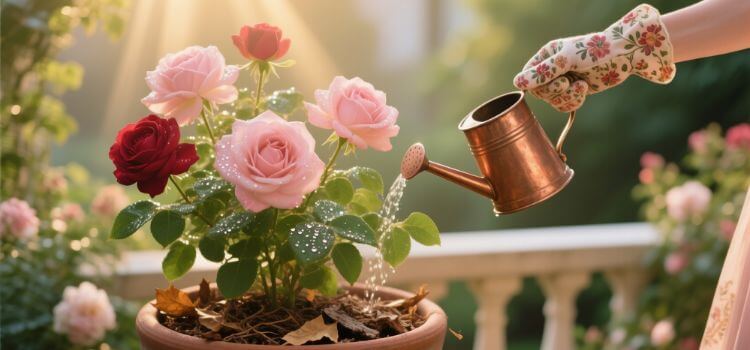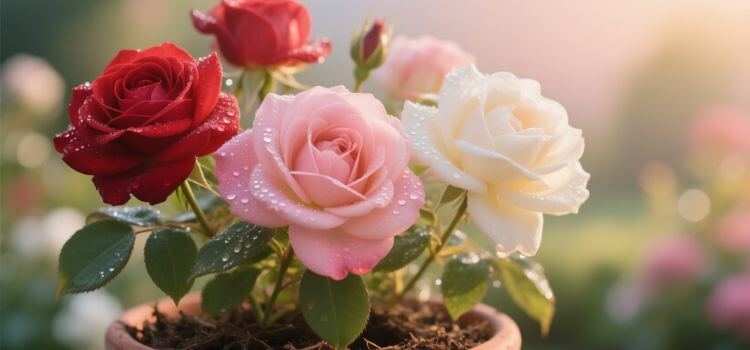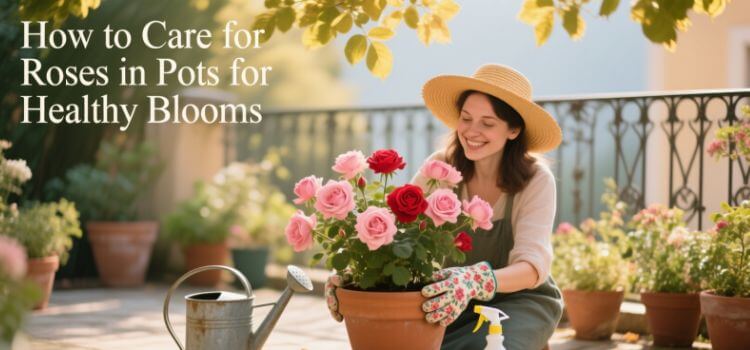As an Amazon Associate, I earn from qualifying purchases.
Do you love roses but don’t have space for a garden? I’ve been in the same situation. That’s why I started growing roses in pots, right on my balcony. The good news is you can enjoy beautiful roses in pots if you know the right way to care for them.
This guide will help you learn how to care for roses in pots, using easy language and straightforward steps. Whether you live in a small flat or have limited outdoor space, you’ll still be able to grow healthy, colourful roses that brighten up your home.
Roses are one of the most loved flowers in the world. They symbolise love, peace, and beauty. But they also need care, just like any living thing. When you grow them in pots, the care routine becomes a little different.
So, how do you get started? Let’s walk through the process together and make sure your potted roses grow strong and happy.
What Kind of Pot and Soil Is Best for Potted Roses?
When growing roses in pots, your container and soil choices matter a lot. A poor setup can lead to weak plants and dull blooms.
Choose a pot that is at least 12–15 inches deep and wide. Clay or ceramic pots are great because they let air move through the soil. Make sure your pot has drainage holes. Without drainage, your rose’s roots will rot.
For soil, use a well-draining potting mix. Don’t use garden soil—it’s too heavy and may hold too much water.
Here’s a good mix:
- 60% potting soil
- 20% compost (like from kitchen waste)
- 10% coco peat or perlite (for drainage)
- 10% sand (for texture)
If you’re looking for long-term success, follow organic soil preparation methods. Roses love rich, living soil. You can add banana peels or coffee grounds occasionally for natural feeding.
Note: Avoid placing your pot directly on a solid surface. Keep it slightly elevated to let water drain out freely.
Note: Organic matter, like compost, also improves the texture and health of your soil over time.

How Much Sunlight and Water Do Roses in Pots Need?
Roses are sun lovers. They need at least 6 hours of direct sunlight every day. Place the pot in a spot where it can get morning sun—it’s less harsh and great for blooming.
Too little sun makes roses weak and increases the chance of pests. If you live in a hot area like parts of South Asia, provide some shade during the hottest part of the day.
Watering needs to be careful. Too much water leads to root rot. Too little, and your rose will dry out.
Here’s a simple rule:
- Water when the top 1 inch of soil feels dry.
- Use a watering can, not a hose. Pour slowly until water drains from the bottom.
- In hot months, water daily. In cool weather, every 2–3 days is enough.
Also, mulch the topsoil with dry leaves or bark. It keeps moisture in and prevents weeds.
How Can You Feed and Fertilise Roses in Containers?
Potted roses need regular feeding. Since the soil in pots is limited, nutrients get used up fast.
Start with vegetable garden soil preparation techniques, which include adding compost every month. Organic compost adds life to the soil and helps with water retention.
Natural fertilisers to use:
- Compost tea (from kitchen waste)
- Fish emulsion (twice a month)
- Banana peel water (once a week)
- Vermicompost (adds good microbes)
Apply these around the base, not on the leaves. Always water after feeding. It helps nutrients reach the roots.
Avoid chemical fertilisers if possible. They can harm the delicate root system in containers.
I’ve used a mix of compost and bone meal in the past. It gave me bigger flowers and more blooms per plant.
What Are Common Problems With Potted Roses and How to Fix Them?
Even with care, roses may face problems. Don’t worry—most issues have simple fixes.
1. Yellow Leaves
- It may be caused by overwatering or a lack of sunlight.
- Solution: Check drainage, place pot in full sun.
2. Black Spots or Powdery Mildew
- Fungal issues are common in humid climates.
- Solution: Use neem oil spray every 2 weeks.
3. Aphids and Pests
- Minor bugs on leaves and buds.
- Solution: Spray with water and mild soap or neem oil.
4. Slow Growth or No Flowers
- Maybe due to poor soil or old plants.
- Solution: Repot with fresh soil and feed with organic compost.
Always remove dead leaves or flowers. It keeps your plant clean and reduces the chance of disease.

How and When Should You Prune Roses in Pots?
Pruning is like giving your rose a fresh haircut. It helps the plant stay healthy and bloom more.
Best time to prune: Late winter or early spring before new growth starts.
Steps to prune:
- Cut dead or brown stems first.
- Trim weak stems that cross each other.
- Keep the strongest 3–4 stems.
- Make cuts at a 45-degree angle, just above a leaf node.
Use clean, sharp scissors. Dirty tools spread diseases.
After pruning, give your plant compost or banana peel tea. New leaves and buds will follow soon!
Can You Move Potted Roses Indoors or Change Their Location?
Yes, you can move your potted roses. But do it gently.
If heavy rain or storms are coming, shift the pot to a dry, covered spot. During winter, move them near a sunny window or porch to protect them from the cold.
Don’t move them too often. It stresses the plant. If needed, rotate the pot every few days for even sunlight.
When moving pots indoors:
- Place near a bright window
- Reduce watering (less sun = less need)
- Avoid drafty areas like near fans or ACs
I once left my rose on a shaded balcony for two weeks. The leaves turned pale, and buds stopped forming. After moving it back to full sun, the plant recovered in 10 days.
Frequently Asked Questions
Q1: Can I grow roses in small pots?
Only mini roses. Standard roses need bigger pots—at least 12 inches deep.
Q2: How often should I fertilise potted roses?
Every 2 weeks in the growing season, with organic compost or banana peel tea.
Q3: Can I use garden soil for potted roses?
No. Garden soil is too heavy. Use a potting mix with compost and sand.
Q4: Why are my rose buds falling off?
Possible overwatering or sudden change in temperature. Keep watering steady and avoid moving the plant too often.
Q5: Do roses in pots need support?
Yes, tall varieties may need bamboo sticks or trellises to stay upright.
Conclusion
So, now you know how to care for roses in pots the right way.
With the right pot, good soil, regular sunlight, and some composting for garden soil, your roses will grow strong and bloom beautifully.
This is not a hard job. It’s a joyful one. Every morning, I check on my roses and feel a bit more peace inside. They greet me with colors and scents that lift my mood.
Do you love roses but don’t have space for a garden? I’ve been in the same situation. The roses may seem delicate, but with the proper steps, they become strong and stunning.
Go ahead, give it a try. Let your home bloom, one pot at a time.

